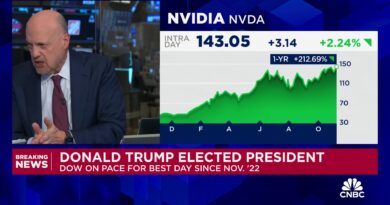Wolfspeed báo cáo doanh thu quý, biên lợi nhuận gộp và EPS ở mức cao trong phạm vi hướng dẫn
News: Microelectronics
22 November 2023
For its fiscal first-quarter 2024 (to end-September 2023), Wolfspeed Inc of Durham, NC, USA – which makes silicon carbide materials as well as silicon carbide (SiC) and gallium nitride (GaN) power-switching & RF semiconductor devices — has reported revenue from continuing operations of $197.4m, down 16.3% on $235.8m last quarter but up 4.2% on $189.4m a year ago.
This was above the midpoint of the updated guidance range of $185–205m, which was reduced from $220–240m after the announcement on 22 August that radio frequency business Wolfspeed RF is being sold to MACOM Technology Solutions Holdings Inc of Lowell, MA, USA for about $75m in cash (subject to a customary purchase price adjustment) plus 711,528 shares of MACOM common stock (valued at $50m based on its 30 trading day trailing average closing price through 21 August). “When the sale is finalized, we will have completed the path towards portfolio optimization that we’ve been on since 2018, when we were predominantly a lighting company,” notes chief financial officer Neill Reynolds. “Wolfspeed is now the world’s only pure-play vertically integrated silicon carbide company, and we can focus all our collective efforts on the silicon carbide materials and power device businesses.”
Power Products revenue was $101.2m, down 3.2% on $104.5m a year ago. Of this, the new Mohawk Valley Fab contributed $4m in revenue, up from $1m last quarter. “Power device revenue was impacted by slower industrial and energy demand, primarily in China and the broader Asian market,” says Reynolds (adding that China represents about 20% of total company revenue, primarily in the industrial and energy space). This was partially offset by the revenue ramp from the Mohawk Valley Fab.
In contrast, Materials Product revenue was $96.2m, up 13.3% on $84.9m a year ago. “Materials 150mm substrate revenue achieved a record quarter, above our expectations, driven by continued strong demand and record manufacturing performance by our Durham materials operations team,” says Reynolds.
On a non-GAAP basis, gross margin has fallen further, from 38.8% a year ago to 15.6%. However, this includes an impact of 1740 basis points (17.4%) from $34.4m of under-utilization costs, since the Mohawk Valley Fab began revenue-generating production at the end of fiscal 2023 and operating it is now reflected in cost of revenue rather than factory start-up costs. It is also towards the high end of the 10–18% guidance range, due largely to improved materials manufacturing performance resulting in better-than-expected 150mm materials costs and yields, as well as the Mohawk Valley Fab under-utilization costs being better than the expected $37m. Also, this is before excluding about 200 basis points of impact from under-utilization in the RF business.
Operating expenses have been cut from $131.2m a year ago to $119.6m in fiscal Q1/2024. This included $8.4m of factory start-up costs from the materials expansion efforts, primarily related to the JP materials facility (John Palmour Manufacturing Center for Silicon Carbide) that is being built in Siler City, North Carolina.
Adjusted net loss from continuing operations has risen from $30.1m ($0.24 per diluted share) a year ago to $66.6m ($0.53 per diluted share). However, this is significantly better than the guidance range of $75–94m ($0.60–0.75 per diluted share) due to the higher-than-expected revenue and gross margin as well as lower operating expenses.
Operating cash flow was –$112.7m in net cash used in operating activities. Capital expenditure (CapEx) remained high, at $404m (up from $66m a year ago). Free cash flow was hence –$517m.
During the quarter, cash, cash equivalents and short-term investments rose from $2955m to $3348m. “In the last year, we have raised approximately $5bn of low-dilution capital across a number of vectors, including customers, governments, private financing and capital markets,” notes Reynolds. “In conjunction with federal funding, we are in good position to execute our capacity expansion plans, but we will remain nimble to optimize our capital structure for the long-term.”
“We kicked off our fiscal year with a strong quarter in both execution and market share,” says president & CEO Gregg Lowe.
Wolfspeed secured its third highest quarterly total of device design-ins at $2.2bn. It also converted a record $1.4bn of device design-wins (more than 230 projects, many of which are converting sooner than expected), “illustrating our customers’ willingness to move into volume production and projects that we’ve won over the past few years,” Lowe adds.
“Our design-in to design-win conversion rate is ahead of our original expectations,” notes Reynolds. “Based on the design-ins we’ve already secured, we have the next few years of expected revenue covered by our existing book of business.”
“We have clear focus on the ramp of our Mohawk Valley Fab,” says Lowe. “At Mohawk Valley, we have an outstanding operations team in place, Building 10 on our Durham campus is producing enough 200mm wafers ahead of the needs of Mohawk Valley, and we already have enough qualified product to satisfy our 20% utilization goals,” he adds.
In 2018, the silicon carbide device market was estimated to be about $400m. Five years later the market size is $6bn. “This further validates our strategy to invest now to capitalize on the immense opportunities at hand, and the significant opportunity in the future,” Lowe continues. “We have amassed significant materials expertise over the decades which, combined with the capacity of our new materials factory in Siler City, will increase our wafer production by 10x when fully operational, and creates significant competitive advantages over our peers and new entrants. We will be better positioned to support our customers’ needs going forward and cater to a whole host of new applications for silicon carbide technology. As the only pure-play silicon carbide company in the market today, we believe that we are best positioned to capitalize on a decades-long tailwind that represents a $20bn addressable market by 2030.”
“This is part of the reason we announced and are now in the process of completing the sale of our RF business to MACOM, which we expect to close by the end of the calendar year,” says Lowe. “The growth of Wolfspeed will come from our leadership in silicon carbide and power devices and this marks a definitive milestone in allocating all of our investments, R&D and technology into these business areas,” he adds.
Durham’s Building 10 200mm crystal growth ramp-up to enable 20% utilization at Mohawk Valley Fab
For fiscal second-quarter 2024 (to end-December 2023), Wolfspeed targets revenue from continuing operations of $192–222m, driven largely by revenue from the Mohawk Valley Fab more than doubling to about $10–15m. This will be partially offset by continued softer demand for industrial and energy products, primarily in the China and broader Asia markets. “However, we will look to purpose the supply to where end-demand remains strong,” says Reynolds. “Demand remained strong across the business outside of the industrial and energy markets, particularly in China and Asia.”
Gross margin is expected to be 12–20%. At the 16% midpoint, this includes about $35m or –1700 basis points of under-utilization costs as the Mohawk Valley Fab is ramped up.
“We are ahead of plan in our ramp of Building 10 crystal growth for 200mm substrates. By the end of this quarter, we will be producing enough material to support 15% utilization at Mohawk Valley, putting us nicely on track for our goal of 20% utilization by the June quarter of 2024,” says Lowe.
Targeted operating expenses for fiscal Q2/2024 are about $109m, including $11m of factory start-up costs, primarily related to the JP materials facility in Siler City (which is expected to be producing material in fiscal first-half 2025, for which more than 100 new staff are already being trained).
Net loss from continuing operations is targeted to be $71–88m ($0.56–0.70 per diluted share).
“At Mohawk Valley, we remain on pace for the larger step-up in revenue [doubling again] as we transition into fiscal Q3/2024,” says Reynolds.
“We’ve now doubled the number of products qualified in the last 90 days, and all of those MOSFETs achieved qualifications on the first pass through the fab, which is a strong indication of the underlying capability of the fab,” says Lowe. “Those products we have already qualified have sufficient demand to more than satisfy our short-term 20% utilization target,” he adds. “There will be a lag between 20% utilization and $100m of quarterly revenue [at the end of the quarter to end-December 2024] due to the time between fab starts and shipments to our customers,” he cautions.
Wolfspeed selling RF business to MACOM for $125m
Wolfspeed’s margins fall further while 200mm SiC device fab ramp-up lags
Wolfspeed’s supply chain not impacted by China’s export restrictions on gallium and germanium
Renesas and Wolfspeed sign 10-year silicon carbide wafer supply agreement
Wolfspeed’s revenue growth constrained by 200mm SiC material capacity ramp


